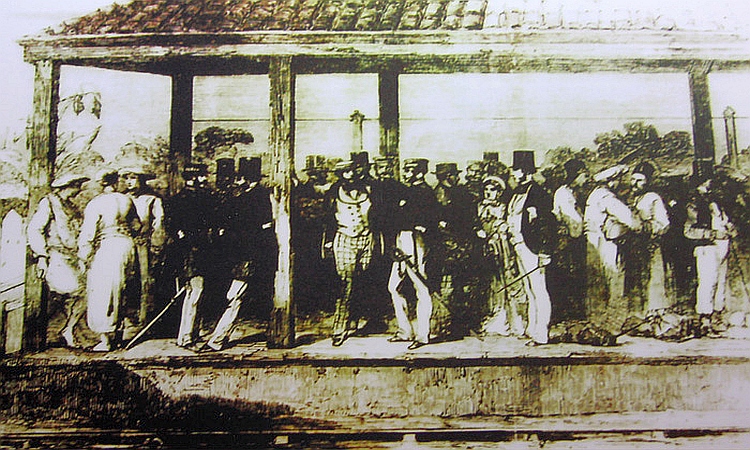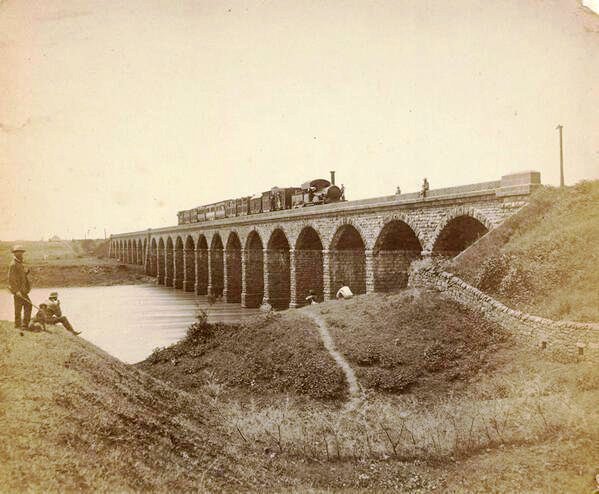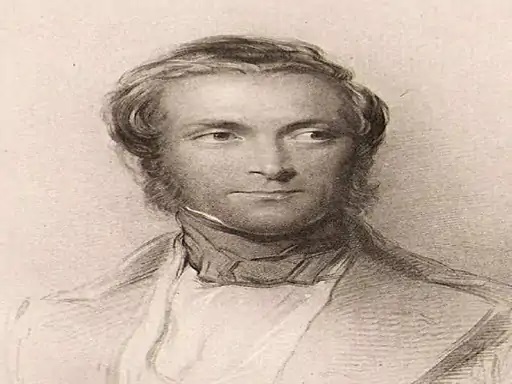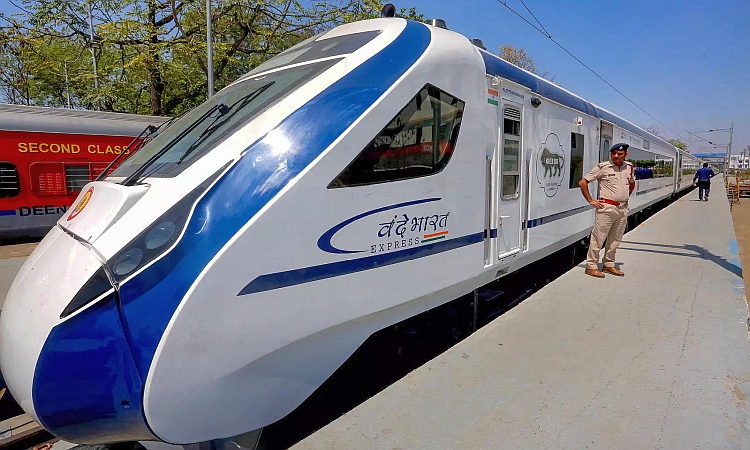Mumbai: Exactly 170 years ago on the same day, i.e. April 16, 1853, the first passenger train was flagged off in India at Bori Bander railway station (now Chhatrapati Shivaji station) when it clocked 3.35pm on watch. Bombay Governor John Elphinstone gave the green light to a passenger train. The train then proceeded, whistling amid 21 cannon salutes. In the next hour and a half, the train reached Thane railway station after covering a distance of 34 km. The train had 14 compartments and carried 400 passengers.
April 16 was declared a public holiday
As it was a momentous day for India, April 16 was declared a public holiday in Bombay (now Mumbai). A huge crowd of onlookers had turned up at the railway station. The anxious crowd of people worshipped the train standing at the station and offered flowers on the track,
According to Australia’s ‘Overloaded Telegram and Courier’, some were putting red vermilion on the track while others were placing fruits and flowers there. Some of them were waiting for the train to move with their eyes closed with incense sticks in their hands. It seemed that the train was nothing short of a divine power for them.

When the train rolled on the railway track, people were shouting in extreme joy. The smoke billowing out of the engine was thrilling them. After travelling about 8 km, the train stopped at Bhaikhla where its engine was filled with water. The train then stopped for a while in Sion. Thus, in an hour and a half journey, the train had 2 stoppages for 15 minutes.
An official’s insistence made the train to run in India
In 1600 AD, the East India Company received a charter from the Queen of Britain. Eight years later, in 1608, it started its business in India as a private company. With no means of transport at this time, the British faced considerable difficulties in transporting goods.
Also Read: Jaipur-Delhi Cantt Vande Bharat Express goes on inaugural run
The first train ran in Britain in 1825, nearly 200 years after the East India Company arrived in India. It had travelled the distance from Stockton to Darlington. In the next few years, people in the United Kingdom began to use the train to move from one place to another and carry goods. Then in 1832, a proposal came to the British official from South India to run trains in India on the lines of Britain. But, not much could be done on it at that moment.
When Lord Dalhousie became Governor General of India in 1848, he decided to run trains in India. Dalhousie had drawn up a plan to bring trains here in 1843, five years before he became Governor General. It was the dream and insistence of the British officer Dalhousie to see the train running on the Indian soil.
Dalhousie’s plan received further impetus when in 1846 the cotton crop in the United States suffered severe losses. Things got to such an extent that textile businessmen from cities like Manchester decided to leave America and come to India. These traders appealed to Dalhousie after he became Governor General to run trains in India.
Also Read: Vande Bharat express to run between Patna & Ranchi from April 25
English officials were already short of trains for moving the army from one place to another and for the business of the East India Company. On 17 August 1849, a year after becoming Governor General, Dalhousie passed a law in the British Parliament called the Great Indian Peninsular Company Act to pave the way for train’s run in India.
Dalhousie handed over command to trusted engineer
After receiving the green signal from the UK Parliament, the biggest problem facing Dalhousie was to select the person who could carry out the job? After much deliberations, he entrusted the responsibility to Arthur Cotton, a civil engineer from Madras.
Also working on his team was Willian Avery, who also designed the first railroad locomotive. By this time, two of the country’s biggest businessmen, Jagannath Shankarsheth and Sir Jamshedji Jijabhai, had formed the Indian Railway Association. The association was also responsible for building the first train, which was being helped by British officials.
In 1851, more than 10,000 workers were engaged in laying tracks and do other works between Mumbai and Thane. All these people were working day and night to realize their dream of running the train within the deadline. As a result, these workers completed their work in 25 months for 20% less than the fixed budget. It was not until 1853 that the first train between Mumbai and Thane was possible.
Bombay-Thane line extended to Kalyan

In 1854 the Bombay-Thane line was advanced to Kalyan. During this period, India’s first railway bridge was built in Thane. Steam locomotives and railway tracks were now rapidly laid in the country. After the successful trial between Mumbai and Thane in 1853, the railway project in India was moved forward at a rapid pace. The very next year the Mumbai-Thane line was advanced to Kalyan. During this period, India’s first railway bridge was built in Thane.
2nd train ran from Howrah to Hooghly
On August 15, 1854, 16 months after the first passenger train ran, a train ran from Howrah in Kolkata to Hooghly for 39 kilometres. Two years later, on July 1, 1856, the first train ran on the 97 km long railway line from Vyasarpadi to Walajarod.
Also Read: No fixed timeline for Mumbai-Ahmedabad bullet train project: RTI
After that, the work of laying railway lines in other parts of the country began. Hitherto the steam locomotives for the trains, which operated were brought from abroad. In 1856, the first steam engines were built in the country. Then, on March 1, 1969, the country’s first superfast train was launched on the broadgauge line. The train was named Rajdhani Express.
Lord Dalhousie, the father of Indian railways
Dalhousie reported to have clashed with railway official over narrow gauge and broad gauge. In 1850, the railway authorities decided to lay standard gauge tracks in India like the rest of the country. Dalhousie, meanwhile, expressed a desire to lay a broad gauge line in India. Dalhousie and the railway officials had a quarrel over this.

In fact, the gauge is the width between two tracks. The width of the standard gauge is 4 feet 8 and a half inches. The broad gauge, on the other hand, is 5 feet 6 inches wide. Dalhousie gave three arguments for laying broad gauge in India…
1. If the gauge is too big, the speed of the train decreases, it makes the journey more safe.
2. In storms, high winds and bad weather train gets more stability in broad gauge than in narrow gauge.
3. In that era the cylinders were installed between the wheels of the train and being broad gauge would have made it easier to install the cylinders.
Also Read: Railways okyas plans to strengthen tracks on strategic North-East front
Eventually, they agreed to lay down the 5-foot 6-inch gauges, which was named broad gauge. When Lord Elgin became Governor-General in 1862, he indicated that smaller gauges would be laid in the country, but the work could not be started. In 1870, the Governor-General, Lord Mayo, decided to introduce a meter gauge system. This meant-width between two tracks 3 feet 3 inches. The width of the gauge was then being measured in meters instead of feet and inches, hence the name meter gauge. In some parts of the country narrow gauge was also laid, the width of which was 2 feet 6 inches. However, in 1990, the railway track was once again converted to broad gauge.
Important trains now running in India
Rajdhani Express run from New Delhi, the country capital, to several capitals of states or the major cities in multiple states. It’s a fully air-conditioned, high-speed, long-distance trains that travel at the highest speed of 130-140 km/hr. Indian Railways now operates 24 pairs of these trains.

Shatabdi Express trains are ultra-fast, thoroughly air-conditioned trains that link major cities in India. Shatabdi express is a day train that goes between medium to short distances and returns on that day itself. Duronto express trains are deluxe, superfast, long-distance trains link various Indian state capitals and metropolises. As of now, India’s rails are home to 26 pairs of Duronto trains.
Jan Shatabdi Express is a less expensive variant of the Shatabdi Express. The ultra-fast day trains include non-air-conditioned and air-conditioned passenger classes (2nd Seating and AC Chair Car). They have a peak speed of 140 km/h. Vande Bharat Express is a new intercity day train with a semi-high speed that is entirely air-conditioned. It has a top speed of 200 km/h, one of India’s fastest trains. This train, also recognised as Train 18, has a variety of amenities, including Wi-Fi, hydraulic-pressure doors, CCTV cameras, a fire/smoke recognition and extinguishing arrangement, and refreshment tables. As many as 15 Vande Bharat express are currently running in the country as on date.




